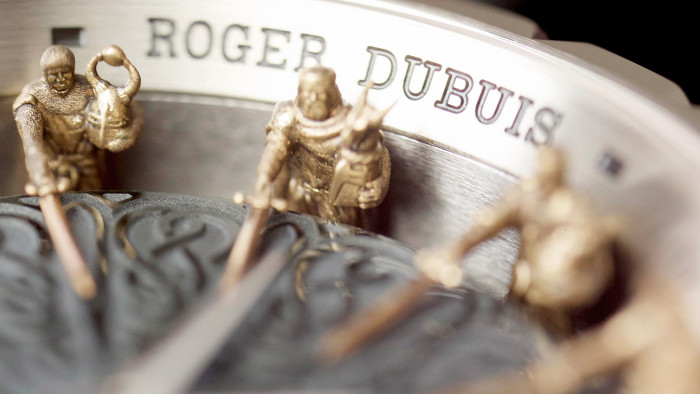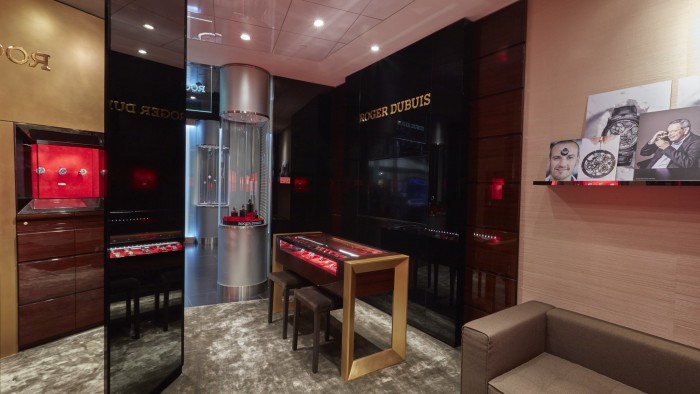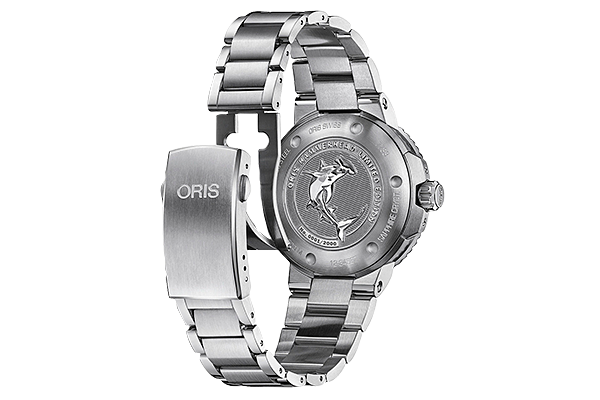Watch news in brief: Apple patents a crowning achievement

Roula Khalaf, Editor of the FT, selects her favourite stories in this weekly newsletter.
The crown found on the side of watches and wound to generate power might seem old-fashioned in the era of the smartwatch, but Apple has taken a new interest in it. The company, which produces the Apple Watch, has filed a patent for a mechanical winding system, resembling a crown, which could be used on its smartwatch to extend its operating time (currently pitched at 18 hours). The application, lodged at the US Patent and Trademark Office, describes a twisting mechanism that creates a rotational magnetic field driving a tiny generator.
Knight time

Roger Dubuis has opened its first UK boutique in the Fine Watch Room at the Harrods department store in London’s Knightsbridge — and celebrated the occasion with the launch of a unique version of its Excalibur Knights of the Round Table model, costing the noble sum of £425,500. The watch features 12 three-dimensional bronze figures (representing each of the knights of Arthurian legend) as hour markers (top), while the dial takes the form of a miniature round table. The brand has also unveiled a one-off version of its skeletonised Excalibur Spider pocket watch, priced at £243,500. The boutique, fitted-out in leather, bronze and wood, is intended to resemble a giant jewel box.
Factory fresh
An architecturally important watch factory in Germany, which once employed 3,000 people and produced 3m timepieces a year, is to be restored to its former glory. The old Junghans HQ in the Black Forest town of Schramberg was designed by industrial architect Philipp Jakob Manz and inaugurated in 1918. Built into the side of a cliff, it comprises nine storeys arranged in terraces, each with 14 windows positioned to take advantage of the uniform northern light. The factory was abandoned decades ago and left to deteriorate, but local spring manufacturing tycoon Dr Hans-Jochem Steim, who bought Junghans in 2009, has vowed to restore the building and open it as a museum. He expects the work to cost €6m and take up to four years.
Slick move

Ulysse Nardin has created one of the most unusual commemorative watches of recent times: its North Sea minute repeater is intended to serve as a “powerful homage to the oil industry”. The watch will be made in an edition of 18 and features a gold and champlevé enamel dial depicting a trio of miniature drilling platforms, with automated derricks that move when the minute repeater is activated. Each watch costs £236,000 — enough to buy to 5,700 barrels of crude at time of writing.
Time out

Panerai has developed a watch designed to run without servicing for half a century — and it is backing this claim with a 50-year guarantee. The LAB-ID Luminor 1950 Carbotech has a movement made from ultra-low-friction materials that do not require additional lubricant. Only 50 examples will be available, at €50,000 a piece.
Complex

In May, Sotheby’s will auction a rare example of a Patek Philippe — which for 26 years held the record for world’s most complicated watch — with an estimate of SFr6.5m-SFr10m ($6.5m-$10m). The Calibre 89 pocket watch marked Patek’s 150th anniversary in 1989 and showcases the brand’s horological prowess with its 33 complications. These include a calendar displaying Easter (which moves each year). Comprising 1,728 components, weighing 1.1kg and measuring 88.2mm in diameter, it was made in four examples. The Calibre 89 remained the world’s most complicated watch until 2015, when Vacheron Constantin unveiled its Reference 57260 with 57 complications. Sotheby’s will exhibit the Calibre 89 in Hong Kong from March 31 to April 4 before its sale in Geneva.
A fishy project

Independent brand Oris has launched a SFr2,550 ($2,500) version of its Aquis dive watch as part of a campaign to further research into the world’s declining shark population. The Oris Hammerhead will be limited to 2,000 and highlights a conservation project being run by non-profit organisation Pelagios Kakunjá. This follows shark movements and researches migration routes of the endangered scalloped hammerhead in the eastern Pacific. The sharks will be tracked using Oris-funded MiniPAT satellite transmitters, which release automatically after six to nine months and float to the surface. The scalloped hammerhead population has fallen by 90 per cent since the 1980s.
Comments